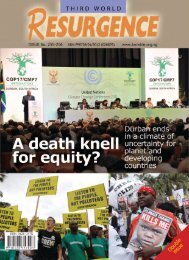Plantations, poverty and power - Critical Information Collective
Plantations, poverty and power - Critical Information Collective
Plantations, poverty and power - Critical Information Collective
You also want an ePaper? Increase the reach of your titles
YUMPU automatically turns print PDFs into web optimized ePapers that Google loves.
150<br />
Conclusion <strong>and</strong> recommendations<br />
It is usual in a report such as this to provide recommendations. After all, we want the pulp <strong>and</strong> paper<br />
industry to improve. However, as this report has hopefully shown, voluntary certification schemes or<br />
voluntary guidelines have completely failed to produce the structural changes needed in the industry.<br />
They have even failed to improve the industry by preventing the most disastrous projects from going<br />
ahead.<br />
Networks of NGOs in North America, Europe <strong>and</strong> Indonesia have produced “Visions” of how they would<br />
like to see the pulp <strong>and</strong> paper industry develop. These “Visions” contain much that is good, such as a<br />
more than 50 per cent reduction of paper production in the case of the European Environmental Paper<br />
Vision. But they don’t go far enough in proposing a radical restructuring of the industry in such a way<br />
that would make redundant the massive industrial tree plantations that the industry is increasingly relying<br />
on.<br />
Here is another vision of the pulp <strong>and</strong> paper industry.<br />
“[I]magine a future scenario: All your separated household waste is collected from outside your house<br />
<strong>and</strong> transported to the local combined <strong>and</strong> very small <strong>power</strong>/pulp/paper mill. What used to go to l<strong>and</strong>fill<br />
goes straight to the fluidized bed boiler along with everything that can be burnt (not paper!) for the supply<br />
of local energy. Your paper for recycling then goes into the pulp mill, along with any local farmers’ raw<br />
material waste that can be used for pulp. Then tissue <strong>and</strong> toilet rolls, cut size A4 <strong>and</strong> any other paper<br />
products that can be made in a miniature, fully automated mill, are produced <strong>and</strong> then delivered to the<br />
local supermarkets ready for the repeat of the next short, lifecycle.” 699<br />
Before you dismiss this as hopelessly radical or out of touch with the real world, I should point out that<br />
this “Vision” comes from Pulp <strong>and</strong> Paper International, a magazine produced for the industry <strong>and</strong> which<br />
usually promotes business as usual for the industry. While we could (<strong>and</strong> should) argue about whether<br />
we really want all our waste to be incinerated (given the pollution involved) <strong>and</strong> need to discuss with<br />
local communities where these minimills are to be built, the proposal to restructure the industry using<br />
small scale regional mills would avoid many of the problems created by today’s pulp <strong>and</strong> paper industry.<br />
It would also help address the problem of overproduction by producing paper that is needed locally. It<br />
would also create jobs.<br />
A UK-based company, BioRegional, has developed such “minimills”. The mills were originally designed<br />
to be used in China, where thous<strong>and</strong>s of small scale mills which used agricultural residues as raw material<br />
have been closed down – partly because they are polluting, but also partly to allow the restructuring of the<br />
industry with massive pulp <strong>and</strong> paper mills, to a large extent reliant on imported pulp. BioRegional’s<br />
minimills would allow China’s small-scale mills to be replaced with far less polluting versions, rather<br />
than closed down. 700 But the minimills could be used anywhere.<br />
In her 1997 book, “The U.S. Paper Industry <strong>and</strong> Sustainable Production: An Argument for<br />
Restructuring”, Maureen Smith looks at the possibilities of restructuring the North American pulp <strong>and</strong><br />
699 Mark Rushton (2008) “Global spotlight, local microscope”, Pulp <strong>and</strong> Paper International, August 2008, page 3.<br />
700 A description of the BioRegional MiniMills project is available here:<br />
http://www.bioregional.com/programme_projects/pap_fibres_prog/minimill/minimill_furtherinf.htm















